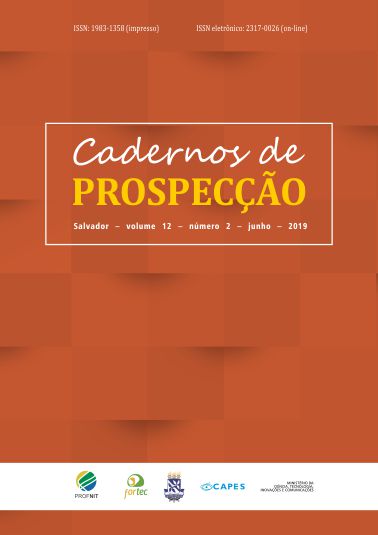Study and Technological Monitoring of Technologies Associated With Hydrophobic Surfaces
DOI:
https://doi.org/10.9771/cp.v12i2.27278Keywords:
Technological monitoring, Patents , Hydrophobic surfaces.Abstract
This article approaches a technological monitoring study in the development of superhydrophobic and hydrophobic surfaces with various application areas. To obtain the information, the Questel Orbit® platform was used, which directs searches in patent documents, being applied as keywords: "Hydrophobic", "surface", "coating", "silica" and "polymer". The "macro", "meso" and "micro" analyzes were carried out to obtain the main technological characteristics related to the types of institutions, the countries and the areas of performance that present the largest patent numbers over the years. Areas of application include areas of coating methods, production techniques, and synthesis and composition. The main raw material used for the production / application were the organic compounds, with emphasis also for the polymeric ones.
Downloads
References
BURKARTER, E. Desenvolvimento de superfícies superhidrofóbicas de politetrafluoretileno. Tese (Doutorado em Física) – Universidade Federal do Paraná. Curitiba, 2010.
CHO, E. et al. Robust multifunctional super-hydrophobic coatings with enhanced water/oil separation, self-cleaning, anti-corrosion, and anti-biological adhesion. Chemical Engineering Journal, [S.l.], v. 314, p. 347–357, 2017.
FERREIRA, L. M. V. Revestimentos Hidrofóbicos. 2013. 77 f. Dissertação (Mestrado em Engenharia de Materiais) – Faculdade de Ciências e Tecnologia da Universidade Nova de Lisboa, 2013.
FIHRI, A. et al. Recent progress in super-hydrophobic coatings used for steel protection: A review. Colloids and Surfaces A: Physicochemical and Engineering Aspects, [S.l.], v. 520, p. 378–390, 2017.
GUO, F. et al. Multifunctional hollow superhydrophobic SiO2 microspheres with robust and self-cleaning and separation of oil/water emulsions properties. Journal of Colloid and Interface Science, [S.l.], v. 494, p. 54–63, 2017.
HAMDI, B. et al. Ageing process of some pyrogenic silica samples exposed to controlled relative humidities Part I: Kinetic of water sorption and evolution of the surface silanol density. Colloids and Surfaces A: Physicochemical and Engineering Aspects, [S.l.], v. 491, p. 62–69, 2016.
JIN, Y. et al. Super-hydrophobic and superoleophilic polydimethylsiloxane-coated cotton for oil–water separation process: An evidence of the relationship between its loading capacity and oil absorption ability. Journal of Hazardous Materials, [S.l.], v. 300, p. 175–181, 2015.
MOHAMED, A. M. A.; ABDULLAH, A. M.; YOUNAN, N. Y. Corrosion behavior of super-hydrophobic surfaces: A review. Arabian Journal of Chemistry, [S.l.], v. 8, p. 749–765, 2015.
PORTER, A. L. Technology futures analysis: towards integration of the field and new methods. Technological Forecasting and Social Change, [S.l.], v. 71, p. 287–303, 2004.
PAL, S. et al. Molecular dynamics simulation of water near nanostructured hydrophobic surfaces: interfacial energies. Chemical Physics and Physical Chemistry, [S.l.], v. 6, p. 1641–1649, 2005.
QUESTEL ORBIT. Orbit Intelligence. 2018. Disponível em: <https://www.orbit.com/>. Acesso em: 20 out. 2018.
SACILOTTO, D. G. Obtenção e caracterização de revestimento hidrofóbico utilizando viniltrietoxisilano (VTES) como precursor em solução sol-gel sobre aço inoxidável AISI 204 por dip-coating. 2015. 115 f. Dissertação (Mestrado em Engenharia de Materiais) – Programa de Pós-Graduação em Engenharia de Minas, Metalúrgica e de Materiais PPGE3M, Laboratório de Corrosão, Proteção e Reciclagem de Materiais. Universidade Federal do Rio Grande do Sul. Porto Alegre, 2015.
SHIN, S. et al. Bio-Inspired Extreme Wetting Surfaces for Biomedical Applications. Materials, [S.l.], v. 9, p. 1–116, 2016.
VAZIRINASAB, E.; JAFARI, R.; MOMEN, G. Application of superhydrophobic coatings as a corrosion barrier: A review. Surface and Coatings Technology, [S.l.], v. 341, p. 40–56, 2018.
YAN, Y. Y.; GAO, N.; BARTHLOTT, W. Mimicking natural superhydrophobic surfaces and grasping the wetting process: A review on recent progress in preparing superhydrophobic surfaces. Advances in Colloid and Interface Science, [S,l.], v. 169, n. 1.-2, p. 80–105, 2011.
YANG, Z. et al. Superhydrophobic epoxy coating modified by fluorographene used for anti-corrosion and self-cleaning. Applied Surface Science, [S.l.], v. 401, p. 146–155, 2017.
YILGÖR, I.; YILGÖR, E.; SÖZ, C. K. Superhydrophobic Polymer Surfaces: Preparation, Properties and Applications. 1. ed. Turkey: Smithers Information Ltda., 2016.
ZHENG, D. et al. Superhydrophobic surfaces for corrosion protection: a review of recent progresses and future directions. Journal of Coatings Technology and Research, [S.l.], v. 13, p. 11–29, 2016.
Downloads
Published
How to Cite
Issue
Section
License
Copyright (c) 2019 Cadernos de Prospecção

This work is licensed under a Creative Commons Attribution-NonCommercial 4.0 International License.
O autor declara que: - Todos os autores foram nomeados. - Está submetendo o manuscrito com o consentimento dos outros autores. - Caso o trabalho submetido tiver sido contratado por algum empregador, tem o consentimento do referido empregador. - Os autores estão cientes de que é condição de publicação que os manuscritos submetidos a esta revista não tenham sido publicados anteriormente e não sejam submetidos ou publicados simultaneamente em outro periódico sem prévia autorização do Conselho Editorial. - Os autores concordam que o seu artigo ou parte dele possa ser distribuído e/ou reproduzido por qualquer forma, incluindo traduções, desde que sejam citados de modo completo esta revista e os autores do manuscrito. - Revista Cadernos de Prospecção está licenciado com uma Licença Creative Commons Attribution 4.0. Esta licença permite que outros remixem, adaptem e criem a partir do seu trabalho para fins não comerciais, e embora os novos trabalhos tenham de lhe atribuir o devido crédito e não possam ser usados para fins comerciais, os usuários não têm de licenciar esses trabalhos derivados sob os mesmos termos.
Este obra está licenciado com uma Licença Creative Commons Atribuição 4.0 Internacional.








